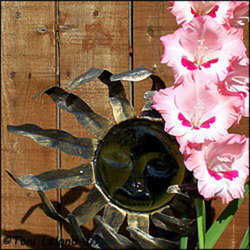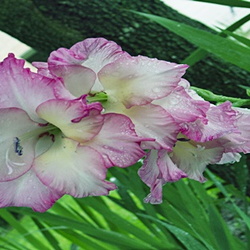(Editor's Note: This article was originally published on August 18, 2008)
Origin of popular garden glads
The first hybrid glads appeared in European nurseries around 1837. Victorian gardeners, Monet included, adored them. They were first hybridized by English horticulturist, Dean Herbert, beginning in 1810. He used various species glads from the Cape of South Africa. These included G. angustus, G. cardinalis (at right), G. carneus (top left below), and G. tristis (bottom left below). Other hybridizers soon followed suit. Among them were the great French nurseryman, Victor Lemoine, and German plantsman, Max Leichtlin. Sadly, none of these hybrids appear in gardens today. As more and more glad varieties--today numbering in the thousands--flooded the market, older varieties were abandoned and lost forever. It is now very difficult to find varieties dating back beyond the 1940s.

Linguistic roots The word "Gladiolus" comes from the Roman gladius meaning sword. A small or diminutive sword was called a gladiolus. Carolus Linnaeus of Sweden, often called the Father of Plant Taxonomy[1], is said to have chosen the name gladiolus because of the plant's sword-shaped leaves. The word gladiator shares the same root (glad-) and refers to a Roman soldier who "lived or died by the sword." Common names for the gladiolus include glad, corn-flag, corn iris, and sword-lily. the same root (glad-) and refers to a Roman soldier who "lived or died by the sword." Common names for the gladiolus include glad, corn-flag, corn iris, and sword-lily.
PopularityWhy are glads so popular? Because they have so many worthy attributes: · Low cost · Ease of culture · Relatively free of insect pests · Extremely wide color range · Long blooming season · Rapid increase in corms[2] · Easy carry-over from year to year in zones where they are not hardy
|
You can also propagate glads by division of the older corms. If large corms have two buds, the corm can be cut in two so that each section has a bud. Wait a day or two before planting these divisions to give them a chance to dry and "heal" for several days.
Generally speaking, the only soil glads will not do well in is in soil that drains poorly. (If puddles remain on your soil for 24 hours after a good rain, it is too wet to grow glads.) It is best to plant corms in full sun. You will be rewarded with brighter colors, and stalks will be sturdier than when planted in partial shade, where they tend to flop over. In gardening zones where the ground freezes in the winter, you can plant corms as soon as the soil is workable in the spring. In our Zone 5 gardens, that usually translates into early April. By staggering plantings up to mid-June, we can have continuous bloom right up to the first frost. Depending on the variety and on growing conditions, your glads will bloom as early as 60 days from planting to as late as 120 days. StorageDig corms in the fall, when foliage begins to yellow and die back. Make sure that you have harvested all the corms by the time of the first hard freeze. If possible, dig corms when the soil is dry to make digging and cleaning easier. Shake off any loose soil, being careful to save any cormels you may want for future propagation. Breaking off the plant as close to the corm as possible, rather than cutting it, will leave a small hole in the husk on the top of the corm. This allows moisture in the corm to evaporate faster during the drying process. It is important to dry corms as fast as possible to prevent breakdown during storage. Make sure that the corms are clean before you store them. I do this by running water over them and, if necessary, scrubbing them gently with a vegetable brush. To dry them more quickly, I place the corms on top of inverted plant trays (the kind that have holes in the bottom) to promote air circulation around the corms. Then I locate the trays near the furnace in our basement to provide a warm, dry place for the corms to cure. Allow about two weeks' curing time. Remove the corms from the trays, turn the trays right side up and fill each tray with one layer of corms. Do not stack corms or trays on top of each other. I store the corms in a dark, unheated room in the basement where the temperature ranges from approximately 35-45°F. You may dust corms with any insecticide labeled for thrips. Since I garden organically, I don't use pesticides and, luckily, have never had a disease problem with glads. If you've never planted glads in your garden before, I urge you to try them. They are easy to grow and will reward you with spectacular blooms in the garden as well as in the vase. Individual flowers look lovely floating in a glass bowl. With the help of some florist tape and pins, I've even made a corsage for my wife. It got oohs and aahs from admirers of "that beautiful orchid you're wearing!"
|
|||||||||||||||
| © Larry Rettig 2008 1Linnaeus' system for naming, ranking, and classifying plants is still in use today. Find out more about Linnaeus here: http://www.ucmp.berkeley.edu/history/linnaeus.html. 2A corm is a swollen underground plant stem that serves as a storage organ. Thanks to Nevin Smith at Suncrest Wholesale Nurseries for permission to use the G. cardinals photo. G. carneus and G. tristis photos are from sulkyrob. For additional information and photos of modern glads, see Toni Leland's May 26 article, Gladiolus: Summer's Magnificent Showcase More glad photos are available in the DG PlantFiles |
||||||||||||||||



















